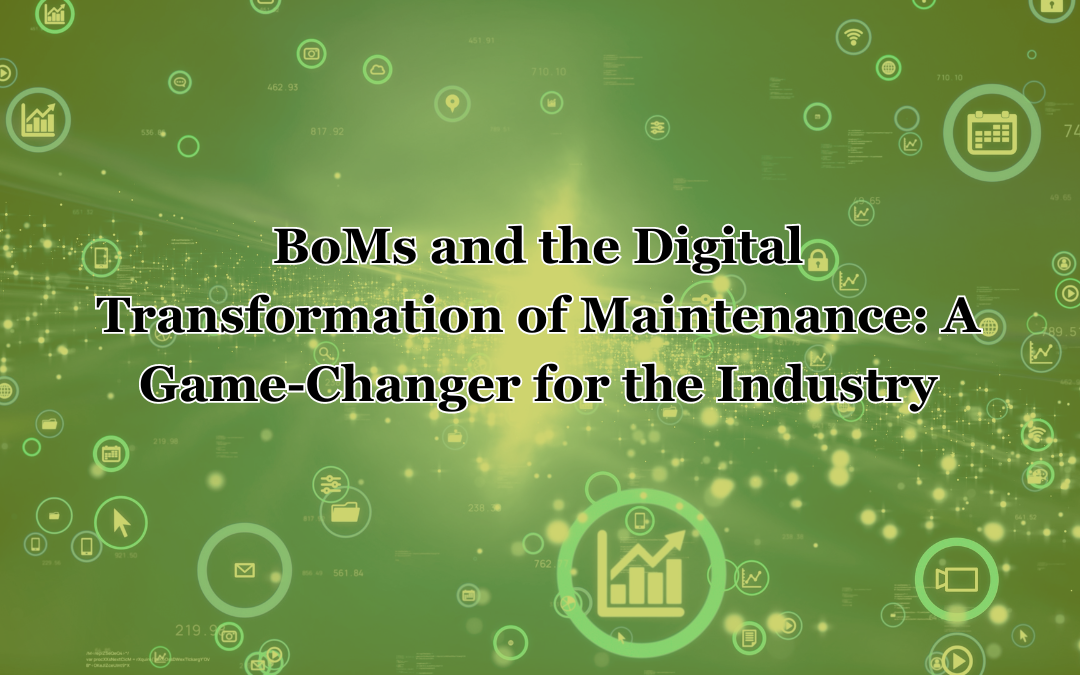In today’s dynamic industrial landscape, the fusion of digital technology and traditional maintenance processes is improving the way businesses manage their assets. Central to this transformation is the strategic use of Bills of Materials (BoMs), which serve as essential blueprints for maintenance and contribute to streamlined, cost-effective, and efficient operations. In this blog, we’ll explore the significance of BoMs and their pivotal role in the ongoing digital transformation of maintenance processes.

The Digital Transformation in Maintenance
Digital transformation is the process of adopting digital technologies to enhance operational efficiency and decision-making. Within maintenance, this transformation includes the integration of various digital tools, data analytics, and automation to optimize equipment upkeep and minimize downtime. Here’s how this transformation is reshaping maintenance processes:
1. Predictive Maintenance: Traditional reactive maintenance is giving way to predictive maintenance, which leverages sensor data and equipment insights to forecast maintenance requirements. This proactive approach not only prevents unexpected breakdowns but also saves organizations substantial costs.
2. Condition-Based Maintenance: Real-time monitoring of equipment conditions enables proactive interventions, focusing maintenance efforts where they are most needed. This extends equipment life and reduces operational costs.
3. IoT and Sensor Integration: The Internet of Things (IoT) plays a pivotal role in collecting real-time data from various sensors, empowering maintenance teams to make data-driven decisions. These data can include temperature, vibration, humidity, and other factors crucial for equipment health.
4. Digital Twin Technology: Digital twins, virtual replicas of physical equipment, allow maintenance teams to visualize and simulate real-world scenarios, facilitating better decision-making and predictive analysis.
Implementation Challenges and Best Practices
While the digital transformation of maintenance processes and the use of BoMs offer numerous benefits, there are also challenges to overcome. Here are some best practices to consider:
1. Data Integration: Ensure seamless data flow between digital tools, such as Computerized Maintenance Management Systems (CMMS) and BoM software, to avoid siloed data and inefficiencies.
2. Data Security: Protect sensitive maintenance data from cyber threats by implementing robust cybersecurity measures. Data integrity and security are paramount.
3. Workforce Development: Invest in training and upskilling your workforce to ensure they are proficient in using digital tools and interpreting BoMs. A knowledgeable workforce is crucial for success.
4. Regular Updates: Keep your digital systems and BoMs up to date to reflect changes in equipment and components. Accurate data is the foundation of effective maintenance.

The digital transformation of maintenance processes, coupled with the strategic use of Bills of Materials, is reshaping industries, offering unparalleled opportunities for enhanced efficiency, reduced downtime, and cost savings. However, the impact is twofold, with industries that struggle to adapt potentially facing risks and hurdles. Navigating the digital age of maintenance requires a balanced approach, leveraging the benefits while addressing the challenges. With Bills of Materials at the core of these initiatives, organizations can ensure a successful and sustainable transformation, ultimately securing a competitive edge in the evolving industrial landscape.
How Can We Help You?
Hubhead’s Building BoM solution can assist you in creating effective bills of materials as well as guide you through this digital transformation of the industry. To learn more about how we can help you build better BOMs, contact us to book a demo or download our brochure.
Why Maintenance BOMs Need to be Accurate
Tips To Create Good Quality Maintenance BOMs
Signs you should start building a BOM
Share this article




